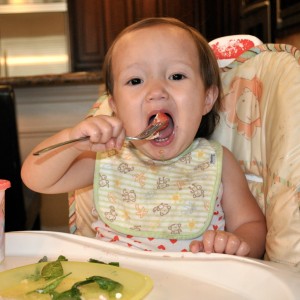Simple Strategy to Avoid Food Battles: Create a Diversion

Your child bangs her cup on the table and glares. Or she yells, “I hate beets!” and grabs a handful and rears back for a pitch. Or she may simply say, “Yuck! I’m not eating that!” to your sumptuous dinner.
What next?
Wouldn’t you do almost anything to have a little peace at the dinner table?
At such moments, wouldn’t it be great to have a way to keep a child on track without the usual yelling, threats, arguments, lectures, punishments—all with limited effectiveness? Wouldn’t you like to be able to have a meal without misery (your child’s or yours)? Do you need a path to resolving conflicts of will where nothing’s broken, no one’s screaming and no food is thrown on the floor? Are you sick of meeting headstrong resistance head on and getting nowhere?
The good news is that nothing extreme is called for. The solution may be very simple.
How to Get a Kid to Do Something
When things are about to blow, try creating a diversion. Offer an alternative. In the book How to Get People to Do Things (1979), author Robert Conklin calls it taking a detour. It’s a simple, effective, low-key way to keep a situation from going where you don’t want it to go with a child (or maybe an adult). It only requires that you be alert and tuned in to your child, yet nonchalant and cool.
- When Serina bangs her cup, be quick. Interrupt the action long enough to calmly suggest another idea or activity that can become as attractive to Serina as throwing a fit:
“Serina, could you please help me get watermelon for everybody?”
- Be quick again and intercept Serina’s little fistful of beets, saying only, “Food stays on the table.” Remove the beets, but not too far away. Then say:
“Serina, did you tell Daddy how much fun you had playing in the creek this afternoon?”
After Serina has her resistance neutralized, she might just forget how much she hates beets. You might see her end up reaching out for them (they’re still nearby), in the glow of getting to tell about her fun. Even if she doesn’t this time, her chances of doing so next time are greater than if there had been a fight over them.
Old School Magical Mind Control for Parents and Kids
Creating a diversion is a parenting technique that was recommended some 100 years ago by a British educational reformer, Charlotte Mason, as described by Susan Schaeffer Macaulay in her 1984 book For the Children’s Sake: Educational Foundations for Home and School.
This way of “changing children’s thoughts,” as Mason calls it, lets a child save face without a parent giving in: “Where she cannot yield, she diverts, she does not crush with a sledgehammer.” A new idea diffuses the battle while giving parents an action to replace the pushiness and direct control that are so unhelpful at the table. Getting pushy over what a child puts in her mouth is the last thing you want to do.
“It is a happy thing that the ‘difficult’ children who are the readiest to resist a direct command are often the quickest to respond to the stimulus of an idea,” Mason states.
So next time your child challenges you to a battle over what she won’t eat, maybe acknowledge her feelings, then try giving her something better to think about, and see what happens:
- “OK. I guess you’re not hungry. Did your teacher announce who gets to play Alice in Wonderland in the show?”
- “I know you wanted to keep playing, but it’s time for us all to come to the table together. Did you hear what happened to your sister today at school?”
***
For more examples of how to create a diversion at the table: Taking a detour: One Good Way to Neutralize a Kid’s Food Resistance
For more on our experience with Charlotte Mason education: “How We Cured Our Son’s ADHD.”








Recent Comments